外研版(三年级起点)小学英语六年级上册 Review-Module 课件(共22张PPT)
文档属性
| 名称 | 外研版(三年级起点)小学英语六年级上册 Review-Module 课件(共22张PPT) | 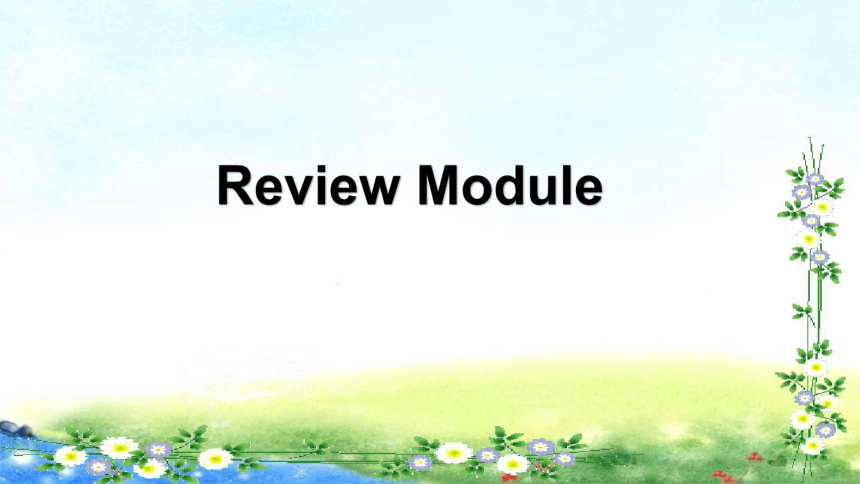 | |
| 格式 | pptx | ||
| 文件大小 | 3.2MB | ||
| 资源类型 | 教案 | ||
| 版本资源 | 外研版(三年级起点) | ||
| 科目 | 英语 | ||
| 更新时间 | 2021-08-18 21:11:57 | ||
图片预览



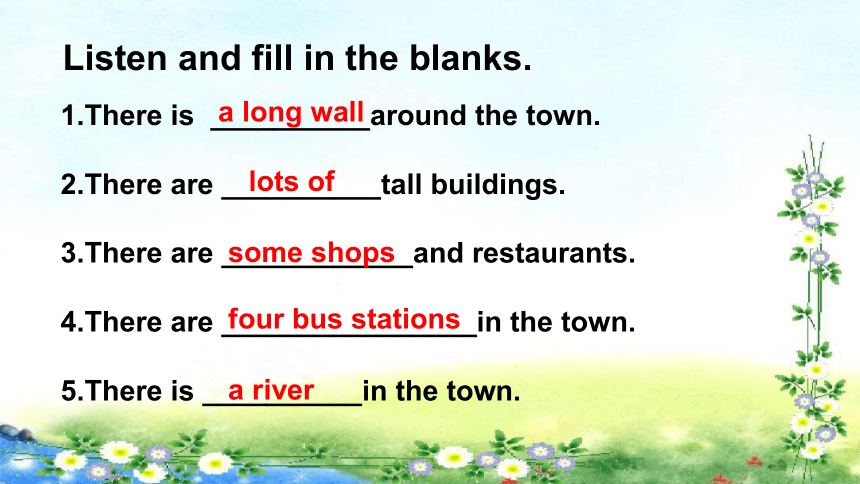
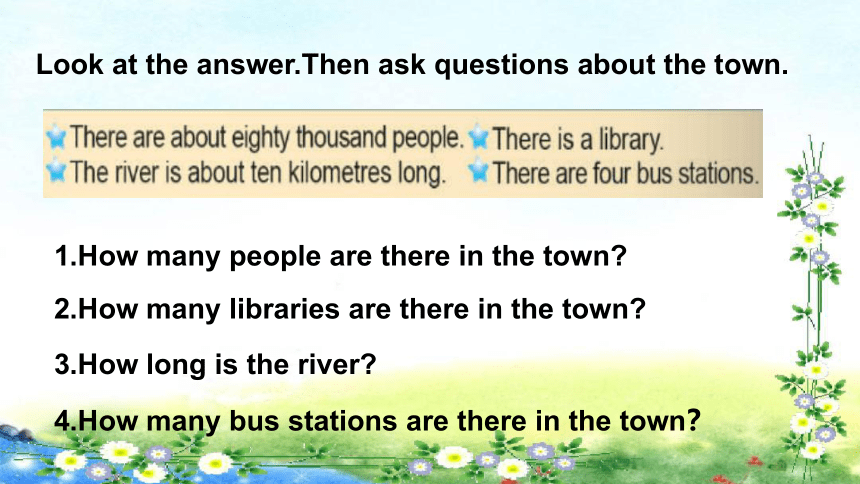
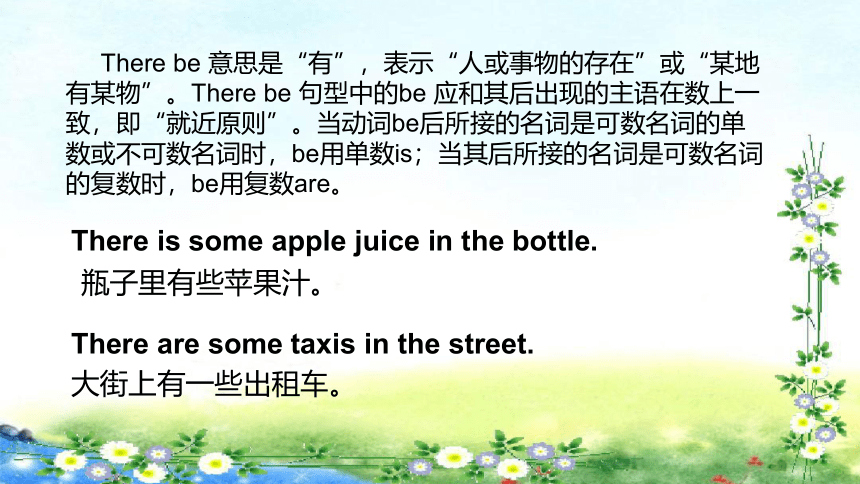
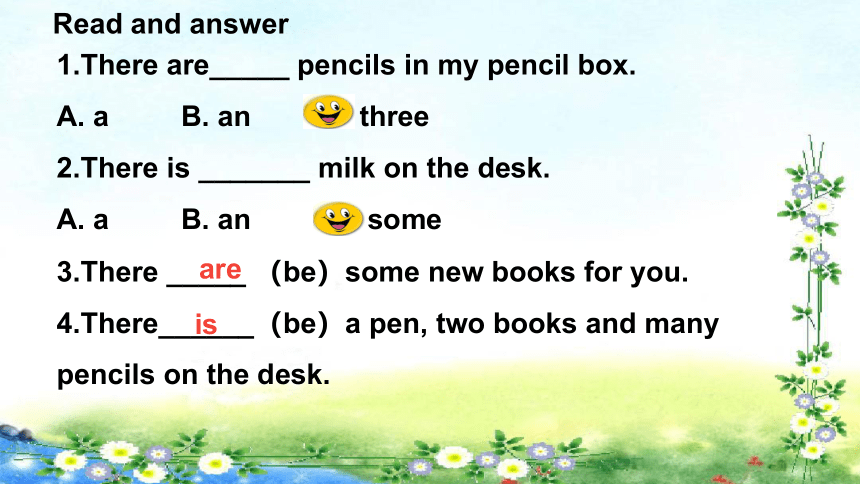


文档简介
(共22张PPT)
Review
Module
Let's
chant.
1.Are
there
any
tall
buildings
in
the
town?
2.How
long
is
the
river?
Yes,
there
are.
It's
about
ten
kilometres
long.
Listen
and
answer.
1.There
is
__________around
the
town.
2.There
are
__________tall
buildings.
3.There
are
____________and
restaurants.
4.There
are
________________in
the
town.
5.There
is
__________in
the
town.
a
long
wall
lots
of
some
shops
a
river
four
bus
stations
Listen
and
fill
in
the
blanks.
1.How
many
people
are
there
in
the
town?
4.How
many
bus
stations
are
there
in
the
town?
3.How
long
is
the
river?
2.How
many
libraries
are
there
in
the
town?
Look
at
the
answer.Then
ask
questions
about
the
town.
There
be
意思是“有”,表示“人或事物的存在”或“某地有某物”。There
be
句型中的be
应和其后出现的主语在数上一致,即“就近原则”。当动词be后所接的名词是可数名词的单数或不可数名词时,be用单数is;当其后所接的名词是可数名词的复数时,be用复数are。
There
is
some
apple
juice
in
the
bottle.
There
are
some
taxis
in
the
street.
瓶子里有些苹果汁。
大街上有一些出租车。
1.There
are_____
pencils
in
my
pencil
box.
A.
a
B.
an
C.
three
2.There
is
_______
milk
on
the
desk.
A.
a
B.
an
C.
some
3.There
_____
(be)some
new
books
for
you.
4.There______(be)a
pen,
two
books
and
many
pencils
on
the
desk.
are
is
Read
and
answer
Have/Has
got句型:它表示某物归某人所有,是一种所属关系,主语为人。
Have/Has
got句型:
A.否定句:在Have或Has后加not,缩写为Haven't或Hasn't。
B.疑问句:把Have或Has提前。
Have
you
got
a
book
about
the
US?
Yes,I
have.
你有一本关于美国的书吗?
No,I
haven't.
是的,我有。
不,我没有。
He
has
got
a
Chinese
dragon
kite.
他有一个中国龙风筝。
No,she
hasn't.
She
has
got
black
hair.
Yes,he
has.
Yes,she
has.
Look
and
write.
根据自己的情况,打√,然后小组内分享。
√
eg:
I
often
read
English
books.
我经常读英语书。
Read
and
tick.
1.I___________read
books.
2.I___________listen
to
music.
3.I___________play
football.
4.I___________watch
TV.
never
sometimes
often
always
always
often
sometimes
never
Fill
in
the
blanks.
祈使句表示要求、命令让他人做某事,常以动词原形开头,出于礼貌我们有时会在句子开头或句子末尾加上please,祈使句的否定形式就是直接在动词前面加上Don’t,意为“不要……”
祈
使
句
Don't
ride
your
bicycle
here!
请勿在这里骑自行车。
Go
straight
on!
直着走。
Don't
turn
left.
请勿左转。
Don't
put
the
books
on
the
floor.
Sit
down,
please.
Please
be
quiet.
Stand
up,please.
Please
speak
English.
Don't
walk
in
the
grass.
Please
sing
English
song.
Point
and
say.
Can的用法:1.主语+can+其他。
2.主语+can't+其他。
3.疑问句:Can+主语+其他?
Yes,...
can./No,
...can't.
I
can
speak
French.
我会说法语。
He
can't
play
football.
他不会踢足球。
Can
you
be
my
pen
friend?
你能成为我笔友吗?
English
and
you
Write
your
answer
to
the
question.
现在,你是个小记者,在组内采访刚才所填写的表格,一定要根据自己的实际来回答哦!
Group
work
There
be
意思是“有”,表示“人或事物的存在”或“某地有某物”。There
be
句型中的be
应和其后出现的主语在数上一致,即“就近原则”。
Have/Has
got句型:它表示某物归某人所有,是一种所属关系,主语为人。
Can的用法:
1.主语+can+其他
2.主语+can't+其他。3.疑问句:Can+主语+其他?
祈使句表示要求、命令让他人做某事,常以动词原形开头,有时会在句子开头或句子末尾加上please,祈使句的否定形式在动词前面加上Don’t,意为“不要……”
English
and
me
I
can
speak
English.I
can
write
an
email
in
English.
Write
“English
and
me”.You
can
use
the
sentences
from
'Activity
4'.
Unit1:
1.There
be句型。
2.Have
you
got...?
Yes,
I
have./No,
I
haven't.
Unit2:
1.
often,sometimes,never,always
2.
Can
you...?Yes,I
can./No,I
can't.
3.
祈使句。
Homework
1.背诵课文。
2.完成《练习册》本课时对应的练习题。
谢谢欣赏
Review
Module
Let's
chant.
1.Are
there
any
tall
buildings
in
the
town?
2.How
long
is
the
river?
Yes,
there
are.
It's
about
ten
kilometres
long.
Listen
and
answer.
1.There
is
__________around
the
town.
2.There
are
__________tall
buildings.
3.There
are
____________and
restaurants.
4.There
are
________________in
the
town.
5.There
is
__________in
the
town.
a
long
wall
lots
of
some
shops
a
river
four
bus
stations
Listen
and
fill
in
the
blanks.
1.How
many
people
are
there
in
the
town?
4.How
many
bus
stations
are
there
in
the
town?
3.How
long
is
the
river?
2.How
many
libraries
are
there
in
the
town?
Look
at
the
answer.Then
ask
questions
about
the
town.
There
be
意思是“有”,表示“人或事物的存在”或“某地有某物”。There
be
句型中的be
应和其后出现的主语在数上一致,即“就近原则”。当动词be后所接的名词是可数名词的单数或不可数名词时,be用单数is;当其后所接的名词是可数名词的复数时,be用复数are。
There
is
some
apple
juice
in
the
bottle.
There
are
some
taxis
in
the
street.
瓶子里有些苹果汁。
大街上有一些出租车。
1.There
are_____
pencils
in
my
pencil
box.
A.
a
B.
an
C.
three
2.There
is
_______
milk
on
the
desk.
A.
a
B.
an
C.
some
3.There
_____
(be)some
new
books
for
you.
4.There______(be)a
pen,
two
books
and
many
pencils
on
the
desk.
are
is
Read
and
answer
Have/Has
got句型:它表示某物归某人所有,是一种所属关系,主语为人。
Have/Has
got句型:
A.否定句:在Have或Has后加not,缩写为Haven't或Hasn't。
B.疑问句:把Have或Has提前。
Have
you
got
a
book
about
the
US?
Yes,I
have.
你有一本关于美国的书吗?
No,I
haven't.
是的,我有。
不,我没有。
He
has
got
a
Chinese
dragon
kite.
他有一个中国龙风筝。
No,she
hasn't.
She
has
got
black
hair.
Yes,he
has.
Yes,she
has.
Look
and
write.
根据自己的情况,打√,然后小组内分享。
√
eg:
I
often
read
English
books.
我经常读英语书。
Read
and
tick.
1.I___________read
books.
2.I___________listen
to
music.
3.I___________play
football.
4.I___________watch
TV.
never
sometimes
often
always
always
often
sometimes
never
Fill
in
the
blanks.
祈使句表示要求、命令让他人做某事,常以动词原形开头,出于礼貌我们有时会在句子开头或句子末尾加上please,祈使句的否定形式就是直接在动词前面加上Don’t,意为“不要……”
祈
使
句
Don't
ride
your
bicycle
here!
请勿在这里骑自行车。
Go
straight
on!
直着走。
Don't
turn
left.
请勿左转。
Don't
put
the
books
on
the
floor.
Sit
down,
please.
Please
be
quiet.
Stand
up,please.
Please
speak
English.
Don't
walk
in
the
grass.
Please
sing
English
song.
Point
and
say.
Can的用法:1.主语+can+其他。
2.主语+can't+其他。
3.疑问句:Can+主语+其他?
Yes,...
can./No,
...can't.
I
can
speak
French.
我会说法语。
He
can't
play
football.
他不会踢足球。
Can
you
be
my
pen
friend?
你能成为我笔友吗?
English
and
you
Write
your
answer
to
the
question.
现在,你是个小记者,在组内采访刚才所填写的表格,一定要根据自己的实际来回答哦!
Group
work
There
be
意思是“有”,表示“人或事物的存在”或“某地有某物”。There
be
句型中的be
应和其后出现的主语在数上一致,即“就近原则”。
Have/Has
got句型:它表示某物归某人所有,是一种所属关系,主语为人。
Can的用法:
1.主语+can+其他
2.主语+can't+其他。3.疑问句:Can+主语+其他?
祈使句表示要求、命令让他人做某事,常以动词原形开头,有时会在句子开头或句子末尾加上please,祈使句的否定形式在动词前面加上Don’t,意为“不要……”
English
and
me
I
can
speak
English.I
can
write
an
in
English.
Write
“English
and
me”.You
can
use
the
sentences
from
'Activity
4'.
Unit1:
1.There
be句型。
2.Have
you
got...?
Yes,
I
have./No,
I
haven't.
Unit2:
1.
often,sometimes,never,always
2.
Can
you...?Yes,I
can./No,I
can't.
3.
祈使句。
Homework
1.背诵课文。
2.完成《练习册》本课时对应的练习题。
谢谢欣赏
同课章节目录
- Module 1
- Unit 1 It's more than twenty thousand kilometers l
- Unit 2 It's in the west.
- Module 2
- Unit 1 There's Chinese dancing.
- Unit 2 There are lots of beautiful lakes in China.
- Module 3
- Unit 1 Collecting stamps is my hobby.
- Unit 2 What's your hobby?
- Module 4
- Unit 1 Thanksgiving is my favourite festival.
- Unit 2 Our favourite festival is the Spring Festiv
- Module 5
- Unit 1 Can you be my Chinese pen friend?
- Unit 2 I can speak French.
- Module 6
- Unit 1 You've got a letter from New York.
- Unit 2 I've got a stamp from China.
- Module 7
- Unit 1 I don't believe it.
- Unit 2 Pandas love bamboo.
- Module 8
- Unit 1 Do you often play with dolls?
- Unit 2 I often go swimming.
- Module 9
- Unit 1 Do you want to visit the UN building?
- Unit 2 I want to go to Shanghai.
- Review Module
- Unit 1
- Unit 2
- Module 10
- Unit 1 Don't talk in the library.
- Unit 2 Go straight on!
